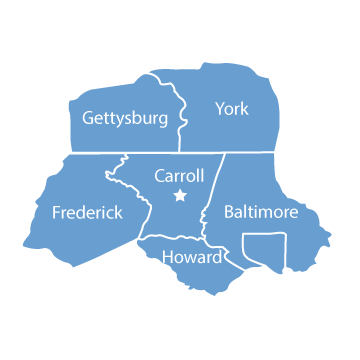Homes in Maryland and Pennsylvania are under attack. The assailant is mold, a microscopic marauder that moves through the air without mercy. While mold spores by themselves are generally harmless, they wreak havoc and harm if they reach a damp spot on your house. Before long, the evidence is overwhelming. What looks like a small spot of dirt or soot starts to spread, and soon your home is covered in large black patches of the moldy menace.
Mold infestations are more than a curb appeal problem, however. Structural damage to siding and other surfaces is a serious concern, and exposure can even lead to a variety of health problems. Here’s some helpful information about mold, the danger it presents, and how to be rid of it.
How Does Mold Get On Your House?
Mold is a fungus that occurs basically anywhere and everywhere in the environment. As it grows, it releases tiny spores into the air, which are then picked up by and travel with the wind. It grows and spreads by feeding on organic material and moisture, which is why it is such a problem on wooden structures. Theoretically, it should not be able to exist on clean and dry non-organic surfaces like concrete and brick. Unfortunately, however, it only takes a thin layer of dirt or dust for it to take hold. Homeowners even have problems with it on vinyl siding, especially when houses are covered with a smorgasbord of pollen and tree sap. Mold thrives in damp, dark conditions, making it a particular problem during the fall and winter months. It can grow at any temperature, and shaded areas are especially prone to the fungus.
What Damage Does It Do?

Although organic material is most at risk, many exterior surfaces can be damaged by mold. Brick walls leak water and retain moisture, leading to a feeding frenzy for it. Like with vinyl siding, it can spread behind and work its way to the plywood and interior drywall. Given enough time, it can eat through wood and result in costly structural damage that also puts your safety at risk. Even concrete is susceptible. A porous substance, untreated concrete retains water that attracts mold, which in turn produces an acid that can compromise the material’s structural integrity.
Mold problems also wreck a house’s resale value, but the biggest victims are those living in the home. Eye, skin, and throat irritation and respiratory problems are possible side effects of exposure to it, and more serious conditions may result for individuals with mold allergies. Although exterior mold growth offers less of a health risk, it can quickly spread indoors where your family will encounter it with every breath they take.
Can It Be Removed?
The good news is most mold growth can be eliminated. There are a variety of commercial products on the market that eradicate it from any surface. Eco-conscious consumers worried about exposure to harmful chemicals also have plenty of options. Baking soda, vinegar, citrus seed extract, and even tea tree oil are effective environmentally friendly mold removers.
The best way to be rid of mold is to prevent it in the first place. Power washing kills it and removes the dirt and debris that encourages mold growth. You can eliminate any problems by scheduling a professional power washing by Peak Power Wash. Not only will our highly-trained technicians remove it and other harmful allergens from your exterior surfaces, but we’ll have your home looking better than ever.



